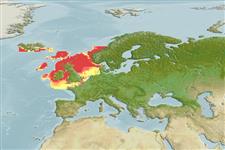>
Gobiiformes (Gobies) >
Gobiidae (Gobies) > Gobionellinae
Etymology: Lebetus: Greek, lebes, -etos = small boiler (Ref. 45335).
Environment: milieu / climate zone / depth range / distribution range
Écologie
marin récifal; profondeur 30 - 375 m (Ref. 35388). Temperate; 65°N - 48°N, 24°W - 13°E
Northeast Atlantic: southwest Iceland, the Faeroes and Hemnefjord, Norway, to northern Bay of Biscay.
Taille / Poids / Âge
Maturity: Lm ? range ? - ? cm
Max length : 4.0 cm SL mâle / non sexé; (Ref. 35388); âge max. reporté: 2.00 années (Ref. 35388)
Rayons mous dorsaux (Total) : 9 - 10; Rayons mous anaux: 7 - 8. Distinguished by having the following characteristics: Reduced suckers (Ref. 92840); pelvic disc without anterior transverse membrane (Ref. 35388).
Inhabits mainly on coarse grounds, especially coralline deposits. Occur in caves and other dark habitats (Ref. 92840). Feeds on small crustaceans (decapods, amphipods), polychaetes and bivalves (Ref. 4696).
Miller, P.J., 1986. Gobiidae. p. 1019-1085. In P.J.P. Whitehead, M.-L. Bauchot, J.-C. Hureau, J. Nielsen and E. Tortonese (eds.) Fishes of the North-eastern Atlantic and the Mediterranean. Volume 3. UNESCO, Paris. (Ref. 4696)
Statut dans la liste rouge de l'IUCN (Ref. 130435: Version 2024-1)
Menace pour l'homme
Harmless
Utilisations par l'homme
Outils
Articles particuliers
Télécharger en XML
Sources Internet
Estimates based on models
Preferred temperature (Ref.
123201): 6.8 - 10.1, mean 7.9 °C (based on 246 cells).
Phylogenetic diversity index (Ref.
82804): PD
50 = 0.7500 [Uniqueness, from 0.5 = low to 2.0 = high].
Bayesian length-weight: a=0.00977 (0.00444 - 0.02153), b=3.04 (2.85 - 3.23), in cm total length, based on LWR estimates for this (Sub)family-body shape (Ref.
93245).
Niveau trophique (Ref.
69278): 3.2 ±0.41 se; based on food items.
Résilience (Ref.
120179): Haut, temps minimum de doublement de population inférieur à 15 mois (tmax=2; tm=1-2; Fec=270).
Fishing Vulnerability (Ref.
59153): Low vulnerability (10 of 100).
